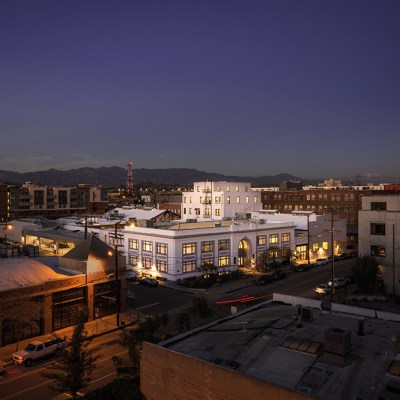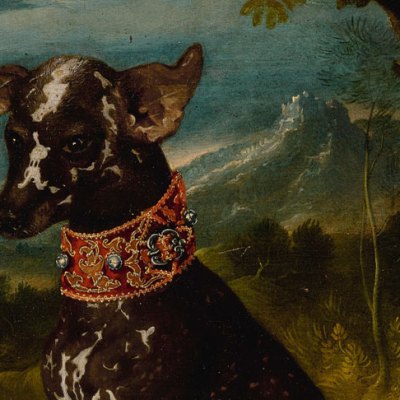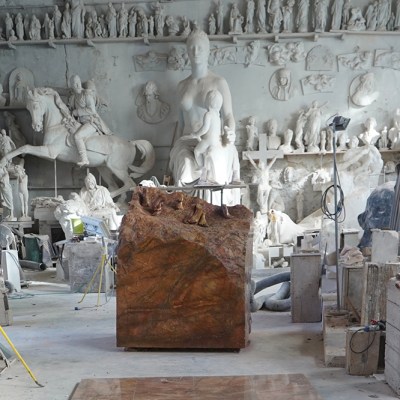Nikita Gale creates large-scale installations employing objects and materials such as barricades, concrete, spotlights and audio elements. Gale’s latest commission for Chisenhale Gallery in London, titled ‘IN A DREAM YOU CLIMB THE STAIRS’, takes Toni Morrison’s novel ‘Song of Solomon’ (1977) as its starting point, imagining the home of the character Circe, who lives with a pack of dogs, as the concrete remnants of a theatre space.
Where is your studio?
My studio is in downtown Los Angeles. It’s a very large kind of warehouse space in a purpose-built studio building. I think there are about 60 other studios on my side of the building, but everyone has very different schedules so it doesn’t feel crowded with people. I don’t really like socialising at my studio. There are some studio buildings that are very social but I think that would be quite distracting for me. I like to keep to myself and to focus on the work.
What’s your studio routine?
It’s very erratic and tends to be determined by the projects I’m working on at that moment in time. Sometimes my studio routine involves me being in my apartment reading and doing research for a couple of hours. When I’m being really good about it, that research process happens at my studio and it is helpful to have that separate space to go and work. I travel a lot but when I’m actually in LA, I probably go to the studio about three times a week.
Do you work with assistants?
I have several fabricators who I work with, who make something for me that they deliver to the studio, and sometimes I work with assistants but not on a very regular basis. I had a studio manager who left me for grad school a couple of months ago, so I’m sort of easing back into the process of becoming open to that relationship again. It’s difficult to find the right chemistry.
What do you like most about your studio?
I like the really big freight elevator and the loading doors and the parking lot, and also being really close to a sink. There are all these little details that became this list of desires. My previous studio was about 250 square feet, maybe not even that, and it was up two flights of stairs with no elevator. Every time I needed to use water, which is often when I’m making my concrete work, I would have to go down the stairs, fill a bucket up with water and carry it back again. The doors were also very narrow, so I was always hoping and praying that the work would fit through the doors when it was time to ship. This studio, however, has really wide doors. I think it helps that artists designed the space and also run the building, so they’re acutely aware of what other artists are looking for in a studio space.
Is there anything that frustrates you about it?
I wish I could make more noise in the studio. We have a low noise policy, which I think is fairly common in studio buildings, but it means I have to do most of my sound editing work at home.
What’s your typical studio lunch?
My studio is close to a vegan restaurant called Café Gratitude. Their menu items are named as affirmations. My favourite salad, for example, is called ‘I am pure’. So that’s what I say when I order it and the person who’s taking the order will usually respond with a daily question or meditation – something to think about while you’re having your meal. It sounds very cheesy, but I find it’s a nice way to break up the day. I always feel more productive when I have a lot of downtime. There’s a lot of prepping and researching before I actually make the work and when I get to that point, it’s usually done in a month or so.
How messy is your studio?
Oh God, it’s so messy! It’s messy to the point where I start to feel self-conscious when I know people are coming to visit. I’m not a very linear thinker when it comes to my work and though it looks really messy, it feels organised to me because I know where everything is. I have this huge table, for example, that’s covered with electronics and bits and pieces of lighting and metal, which is where I do testing for a lot of my projects, and there are shelves along the back wall which are stuffed with materials and equipment. My computer/digital area is pretty neat and organised, though.
What’s the strangest object in there?
I have a load of old cell phones in a little Tupperware box. I’ve had it since I was in grad school and I keep thinking I’m going to do something with it, but I haven’t yet. It may be time to let it go. I acquired the box from eBay along with another container filled with car emblems.
I also have a gigantic flight case. When I first finished grad school, I worked at the Natural History Museum in Los Angeles in the AV and lighting department. I was the person crawling through ceilings and squeezing between walls to wire things and mount projects. They would occasionally get rid of things and one of those things was this flight case, which is extremely heavily and maybe nine feet high and three feet wide. I used it in an installation and show that I had at Commonwealth and Council gallery in Los Angeles in 2018 and now I use it for storage in the studio. It takes up a lot of room but I don’t want to get rid of it because it’s such a cool object.
Which artistic tool could you least do without?
The Internet, because I’m always looking things up and using YouTube tutorials to learn how to do very technical things – it’s a very important tool for learning new skills quickly, but also for checking the safety of something I’m doing. Am I going to die of toxic poisoning if I carry out a certain process inside versus outside? That kind of thing.
Do you pin up any images on the studio walls?
Yes, I have a wall that’s covered in white pegboard and I put up different images and things depending on the vibe of the work. I have a little figurine of the character BMO from the children’s TV show Adventure Time, which was a gift from my brother a few Christmases ago. I think Adventure Time is a really interesting, funny and philosophical show and BMO is this sort of non-binary character; a little game boy device with this weird, nondescript accent. The toy is like my studio mascot. I also have a framed album jacket of Tina Turner’s Private Dancer album, which was a gift from a friend and there are some photographs of Toni Morrison and a photo of Agnes Martin. There are always Post-it notes, too. There’s one on my computer, for example, which says: ‘Learning happens at boundaries.’ I find that really useful to look at when I’m trying to put things together in the studio that don’t quite fit.
Who’s the most interesting person to have visited your studio?
I co-parent a little terrier-cross with my friend who now lives in Boston. The dog’s name is Rufus and he used to come into the studio with me quite a bit. I always really loved having him there because he would always curl up and rest. It was interesting to see which areas he gravitated towards. I wouldn’t really associate my studio with having many soft spots, but he would always find a place with a little softness to it. I guess he made me aware of the spaces that I don’t usually pay much attention to.
‘Nikita Gale: IN A DREAM YOU CLIMB THE STAIRS’ is at Chisenhale Gallery, London, until 16 October.



